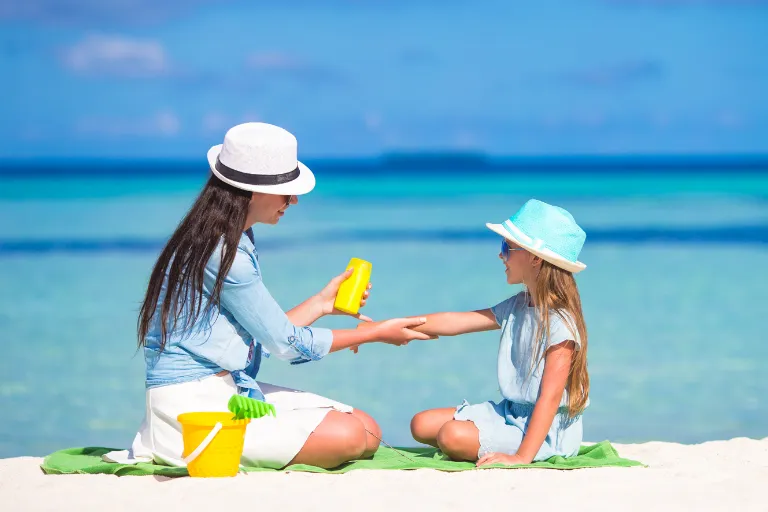Key Points:
- Children’s skin is more vulnerable to UV radiation, increasing lifetime risk for skin cancer.
- Use broad-spectrum mineral sunscreens with SPF 30+; reapply every 2 hours.
- Time outdoor play before 10 a.m. or after 4 p.m. when the sun is less intense.
- UPF-rated clothing, wide-brimmed hats, and shade can significantly reduce UV exposure.
- Sun safety isn’t just for beach days—UV rays can be dangerous even on cloudy days or in winter.
It doesn’t take a tropical vacation to put a child at risk for sun damage. A weekend soccer game, a stroll to the park, or a cloudy afternoon at the pool can expose delicate young skin to ultraviolet (UV) radiation—often without warning signs until a burn appears. According to the Skin Cancer Foundation, just one blistering sunburn in childhood doubles the risk of developing melanoma later in life¹.
Yet, many parents remain unaware of the cumulative dangers of UV exposure or rely on outdated myths (like the belief that darker skin tones don’t require sun protection). The reality? Sun safety is a year-round concern—and one of the most effective long-term health habits parents can teach.
Why It Matters: The Stakes of Early Sun Damage
Children’s skin, still developing and thinner than adults’, absorbs UV radiation more rapidly. This biological vulnerability, combined with their frequent outdoor play, makes sun protection especially critical during childhood and adolescence².
Research shows that up to 80% of lifetime sun exposure occurs before the age of 18³. And according to the Centers for Disease Control and Prevention (CDC), nearly 60% of high school students report at least one sunburn each year⁴—an alarming indicator that sun safety strategies are often falling short.
Cumulative UV damage doesn’t just increase the risk of melanoma. It also accelerates premature aging, causes eye damage (including cataracts), and can suppress immune function in the skin⁵.
What’s Really Going On: The Science of UV and Skin
UV radiation is invisible, but its effects on the body are potent. The sun emits two primary types of UV rays that affect skin:
- UVA rays penetrate deep into the dermis, the skin’s thickest layer. They’re primarily responsible for aging and long-term damage.
- UVB rays affect the outer skin layers and are the main cause of sunburn⁶.
Both types contribute to skin cancer. The UV index, developed by the National Weather Service and the Environmental Protection Agency, measures the strength of solar UV radiation on a scale from 0 (low) to 11+ (extreme). Higher altitudes, reflective surfaces (like water or snow), and geographic regions closer to the equator intensify this exposure⁷.
Unfortunately, UV radiation doesn’t take a vacation when it’s cloudy or cool. Up to 80% of UV rays still pass through cloud cover⁸, and snow reflects as much as 85% of UV light back onto the skin—doubling exposure⁹.
Pediatric Guidelines: What the Experts Say
The American Academy of Pediatrics (AAP) offers age-specific sun safety guidance¹⁰:
- Infants under 6 months: Avoid direct sun exposure entirely. Use shade, breathable UPF clothing, and wide-brimmed hats. Only apply minimal sunscreen to small areas (e.g., hands and face) if sun exposure is unavoidable.
- Toddlers and older children: Encourage play in shaded areas and teach basic sun protection habits. Apply broad-spectrum sunscreen with SPF 30 or higher at least 15 minutes before going outside.
The CDC and World Health Organization (WHO) recommend broad-spectrum sunscreens—those that block both UVA and UVB rays—and advise reapplying every 2 hours, or after swimming or heavy sweating⁴ ¹¹.
Decoding Sunscreen: What to Look For
Not all sunscreens are created equal, and ingredient safety is especially important for children. Here’s what parents need to know:
- Mineral (Physical) Sunscreens use zinc oxide or titanium dioxide to create a physical barrier that reflects UV rays. They’re considered safer for young skin and less likely to cause irritation¹².
- Chemical Sunscreens absorb UV radiation through ingredients like oxybenzone or avobenzone. Some studies have raised concerns about hormone disruption from ingredients like oxybenzone—prompting the FDA to call for further safety testing, particularly for children¹³.
Best practices:
- Choose SPF 30 or higher and look for “broad-spectrum” and “water-resistant” on the label.
- Reapply every 2 hours—more often if swimming or sweating.
- Apply generously: most people under-apply, reducing effectiveness¹⁴.
For children with sensitive skin, fragrance-free, hypoallergenic mineral sunscreens are a safer bet.
Subscribe for Free for more insightful health articles tailored to your needs.
Sun-Protective Clothing: The First Line of Defense
Beyond sunscreen, Ultraviolet Protection Factor (UPF) clothing offers physical, reliable shielding. A UPF rating of 50 blocks 98% of UV rays¹⁵. Look for:
- Wide-brimmed hats that shade the face, ears, and neck.
- Long-sleeved rash guards or swimsuits with built-in UPF.
- UV-blocking sunglasses (labelled UV400) to protect sensitive eyes¹⁶.
Lightweight fabrics like tightly woven cotton or polyester blends allow breathability without sacrificing protection. And unlike sunscreen, clothing doesn’t wash off or need reapplication.
Smart Habits: Shaping a Lifetime of Sun Safety
Sun protection isn’t about fear—it’s about forming healthy, sustainable habits. Here’s how:
- Time it right: Schedule outdoor activities before 10 a.m. or after 4 p.m., when the sun’s rays are less intense¹⁷.
- Make shade a priority: Use umbrellas, canopies, or trees. Teach children to rest in the shade during breaks.
- Make it routine: Apply sunscreen before leaving home. Keep a sun hat and sunglasses in backpacks or strollers.
- Lead by example: Children are more likely to wear sunscreen and hats if parents model the behavior¹⁸.
Busting Common Myths
“My child has darker skin—they don’t need sunscreen.”
→ False. Melanin does provide some natural protection, but it’s not enough. All skin tones can burn and are susceptible to long-term damage¹⁹.
“It’s cloudy—we’re fine without sunscreen.”
→ Not true. Up to 80% of UV rays still reach the skin on overcast days⁸.
“Sun safety only matters during summer vacations.”
→ Wrong. UV exposure is a year-round issue, especially in high-elevation or reflective environments⁷ ⁹.
Final Thoughts: Raising Sun-Savvy Kids
The best sun protection plan isn’t complicated—it’s consistent. By combining broad-spectrum mineral sunscreen, UPF clothing, smart timing, and shade, parents can dramatically reduce their children’s UV exposure and long-term health risks.
Start early, talk openly, and model the habits yourself. Because protecting a child from sunburn isn’t just about today—it’s a gift for their future.
References
- Skin Cancer Foundation: Childhood sunburn and melanoma risk
- WHO: Ultraviolet radiation and children’s skin
- Environmental Protection Agency (EPA): Sun Safety Tips for Children
- CDC: Youth Risk Behavior Surveillance – United States, 2019
- American Cancer Society: Skin Cancer Facts
- FDA: Sunscreen: How to Help Protect Your Skin from the Sun
- NOAA & EPA: UV Index
- WHO: UV radiation levels and protective measures
- Skin Cancer Foundation: Winter sun safety
- AAP: Sun Safety and Protection
- WHO: Sun protection in children
- American Academy of Dermatology: Choosing the right sunscreen
- FDA: Proposed rule on sunscreen ingredients
- CDC: Sunscreen use and application guidelines
- Skin Cancer Foundation: What is UPF Clothing?
- American Optometric Association: UV protection and children’s eyes
- EPA: UV index timing guidelines
- Cancer Council Australia: Children learn sun safety by example
- American Academy of Dermatology: Sun safety for all skin tones
The article does not in any way constitute as medical advice. Please seek consultation with a licensed medical professional before starting any treatment. This website may receive commissions from the links or products mentioned in this article.
Subscribe for Free for more insightful health articles tailored to your needs.



